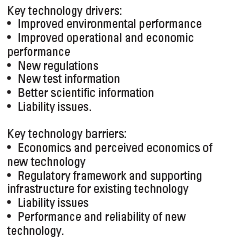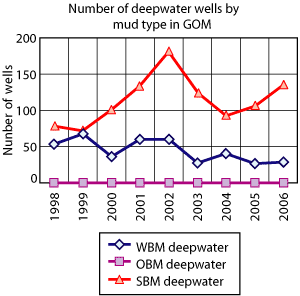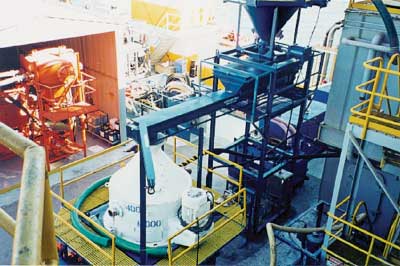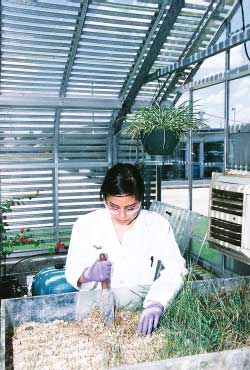Special Focus: HEALTH, SAFETY, ENVIRONMENT
Drilling fluids and waste management developments expose challenges of advancing technology
Successfully navigating regulatory barriers allows synthetic-based mud to enhance deepwater production.
John Candler and Dr. Arthur Leuterman, M-I SWACO
The development of synthetic-based drilling fluids and advancements in the beneficial re-use of drilled cuttings epitomize the challenges in overcoming operational, psychological and legislative barriers to meet the environmental and economic drivers for new technologies.
As reflected in the successful introduction of synthetic-based fluids and the contrasting failure of a new wetlands reclamation technology, bringing developments to market requires breaking down seemingly insurmountable barriers.
TECHNOLOGICAL DRIVERS AND BARRIERS
The engineering of new drilling fluid and waste management systems illustrates how advancing technology is considered the shining star in providing direction and hope for solutions to environmental, operational and economic issues. However, in the quest to develop and implement new technology, the first questions from the end users often are “Which technology meets our needs?” and “Why change from the status quo?”
People tend to become comfortable with established and proven technology. Consequently, they are intrinsically resistant to moving from the familiar to the unknown, even if the latter holds the promise of improving performance significantly. Clearly, one of the most difficult to break barriers to new technology is the sentiment, “Why should we use new technology when the old technology works?”
As new technology is introduced, it is supported by key drivers, while restrained by fundamental barriers, Table 1. Accordingly, only by recognizing these two elements and addressing them effectively can new technology move forward.
| TABLE 1. The primary drivers and barriers affecting the delivery of new technologies |
 |
|
Drivers. Traditionally, key drivers for new technology have been operational and economic. By taking a cost-effective approach toward solving problems and issues, the evaluation of new technology has always been straightforward. The increasing importance of HSE issues makes drivers related to HSE equal to the other two core evaluations. While operational and economic performance is easy to understand at the field level, environmental performance is complex and requires deeper interpretation. Environmental liability is a significant driver, it often take years to accumulate or be recognized while operational and economic performances are evaluated on a daily basis. Typically, new regulations and associated regulatory tests define the limits of environmental performance and frequently serve as a universal structure for competitors to sell their operational and economic performance advantages.
Barriers. In balance with the drivers for new technology are the barriers. At the top of the list for challenges to new technology are costs. The cost of installation, refinement and achieving better operational and environmental performance typically falls on the shoulders of field operations. In some cases, the perception of the cost involved in changing to a new technology easily can outweigh the anticipated benefits of the change.
For instance, once a technology for handling a waste stream has been established, regulations and infrastructure are built around the technology to support it. As new regulations appear, they typically focus on the existing technology and sometimes do not address new or unproven advancements. Liability issues often hinder new approaches to waste management. In the case of beneficial re-use, fear of public exposure to material that traditionally has been viewed as a waste is a significant liability concern. Finally, performance in the field for new technology is not always as good as it is in the laboratory. Consequently, while many new ideas, products and processes are developed, implementation can be slowed or stopped because of barriers that develop for new technology.
Like the process of natural selection, the technology that achieves the best cost and operational performance in the framework of regulations and available commercial products is the winner. Just like the many species that can develop within a certain ecosystem, technologies evolve and adapt to meet the needs of the particular region where they are used.
Organizational influence. As new technology is introduced, there are many organizations that come into play to determine its fate. Understanding key organizations helps to knock down barriers and move technology forward. Oil companies are at the top of the organizations that influence use of new technologies. Clearly, as the end users, oil companies serve as the gatekeepers for new technology. Equally important to new technology are regulatory agencies that are tasked with setting up requirements that are protective of human health and the environment. Supporting these two key players are service companies, research organizations and industry trade groups that work together to help promote introduction of new technology. Independent and equally important as these industry drivers for new technology is the expectation from the public sector that the industry will continuously improve its environmental performance.
TECHNOLOGY ADVANCES: SUCCESS AND FAILURE
The easiest way to show how drivers and barriers influence new technology is to provide examples of new technologies that have been introduced. In the first case, a new drilling fluid technology was successfully implemented, while in our second case, a new drilling fluid technology failed to achieve implementation at the field level.
Traditionally, water-based and oil-based drilling fluids dominated the market until the late 1980s and early 1990s when Synthetic-Based Mud (SBM) was introduced. The need for new drilling fluids technology in the Gulf of Mexico (GOM) was driven by new technical challenges, such as gas hydrates in deepwater drilling environments. New drilling fluid solutions were challenged by environmental permit limitations for toxicity, introduced in the GOM permit limitations in the mid 1980s.
During the development process, pollution prevention opportunities for drilling fluids include improved performance, reduced fluid-related problems, time on location and minimized discharges. Furthermore, higher performance drilling fluids have also opened the door for the use of other technologies such as extended reach drilling. In addition to fluid performance advances, associated mechanical separation equipment also has continued to advance the cause of pollution prevention. One major advancement in mechanical solids control equipment associated with SBM has been cuttings dryers that are being used in some areas to reduce retention of base fluid on cuttings. This new technology can reduce retention of mud on cuttings by 50%.
ADVANCING SBM TECHNOLOGY
An examination of the development history of SBM vividly illustrates the challenge of overcoming barriers to successfully introduce a new technology, Fig. 1.
 |
Fig. 1. The impact of SBM in the deepwater market as opposed to its oil-based (OBM) and water-based (WBM) counterparts.
|
|
Regulatory barriers for SBM. When SBMs were first introduced to the GOM in the early 1990s, the US Environmental Protection Agency (EPA) had just completed writing effluent limitation guidelines for oil and water-based drilling fluids. During this critical introduction time from 1992-2000, the permitted use of SBMs was driven by compliance with the Clean Water Act. The new EPA Effluent Limitation Guidelines, completed in March 1993, authorized the use of drilling fluids with permitted limits for discharge. In the GOM, the key discharge limits for drilling fluids included free oil, toxicity and, in the case of barite, heavy metal limitations. The permit prohibited the discharge of oil-based mud cuttings and any discharge of diesel oil. The permit and associated tests were primarily designed to monitor water-based drilling fluids, and while SBM met the mud limitations, the permit restrictions and required tests served as barriers to the industry-wide acceptance of SBMs.1
Industry and DOE request new approach. In response to the regulatory barriers in place, several oil and service companies approached the EPA within the structure of trade groups. As with many new technologies, the EPA encouraged the investigation of new technology, but was hesitant to begin the process of writing new limitations to more clearly define the acceptance of synthetic-based technology.
In 1995, the US Department of Energy (DOE) contracted Argonne National Laboratory (ANL) to investigate SBMs and help address regulatory barriers that would inhibit their use. The result was a comprehensive document independent of commercial interest that allowed the DOE to request the EPA to address the specific needs of SBM regulatory issues.2 In response to the continued industry advocacy effort and requests from the DOE, the EPA Office of Water committed to address the regulatory issues for synthetic-based muds. This is a key example of how independent research organizations such as ANL and universities can provide independent information on new technology and its costs and potential benefits. In response to information requirements from the EPA, industry work groups were formed and funded in May 1997 to address the following SBM regulatory issues:
- Cuttings retention
- Seafloor survey
- Benthic toxicity testing
- Analytical.
Two more groups were later added to examine modeling and biodegradation testing. Industry trade groups provide a format for oil companies and service companies to come together, evaluate new technology and address barriers in a constructive manner.
EPA develops new guidelines. Eventually, the EPA concluded that effluent limitation guidelines needed to be developed for SBMs. Rather than use the traditional effluent limitation guidelines process, the fluid technology was included in a newly introduced process known as the Presumptive Rulemaking Process (PRP). The EPA moved away from conducting investigations and developing new tests, and relied on industry to do the data collection work and to support new technology with appropriate tests that met the EPA’s regulatory needs. Just as the industry must move forward in their approach to new technology, government regulators must also move forward in their approaches to evaluation and incorporation of new technology.
The new PRP process is an example of the government exploring new methods of technology evaluation. As pollution prevention was one of the key elements to the success of the process, the industry included non-water quality aspects in its evaluation of technology. Thus, operators and service companies spoke with one voice, and the industry relied on sound science and parallel data on fluids. The regulation included performance factors for both fluids and solids-control equipment. The latter included cuttings dryers designed to reduce SBM discharges by 50%.3 Figure 2 shows a cuttings dryer.
 |
Fig. 2. Vibrating centrifuges and other cuttings dryers are being used in some areas to reduce retention of non-aqueous fluids on cuttings.
|
|
In order to avoid promulgating a zero discharge limitation for SBMs, the EPA took a holistic approach and included the following considerations in its selection of controlled discharge of SBM. The EPA documented4 that going to zero discharge would have resulted in:
- 35-million more lbs of cuttings shipped to shore for disposal
- 166-million more lbs of cuttings injected
- Increased fuel use
- A 5,602-ton increase in air pollution
- The discharge of 51-million lbs more of water-based drilling fluid cuttings
- The term duration of landfilling oil-based drilling fluid cuttings is longer than controlled discharge of SBM cuttings.
New guidelines promote SBM technology. The completion of effluent limitation guidelines and permit requirements governing SBM cuttings discharge opened the door for the development of a deepwater GOM projects employing the SBM technology. In the case of SBM, every key organization realized that the benefit of improved operational and environmental performance could only be achieved if each one worked together to successfully introduce the new technology. Thus, some of the drivers agreed upon for the introduction of SBM included:
- Strong economic and technical drivers that required a high performance drilling fluid for deepwater applications.
- Operators, research organizations, industry trade groups and service companies provided significant efforts to address regulatory barriers.
- New regulatory processes were used to speed the process of developing appropriate regulations.
- With guidelines and permits in place, SBMs promote the effective development of deepwater oil and gas in the GOM.
HINDERING RECYLCING MUD AND CUTTINGS IN WETLANDS
In the same time frame as the successful introduction and subsequent acceptance of SBM technology, another development program considered a combination of drilling-fluid design and mechanical equipment that resulted in the drilling mud and cuttings being used as a wetlands substrate.
The new mud system was based on a design for the drilling fluid that contained either inert or beneficial constituents that meet the drilling requirements. Other key criteria included designing a dewatering and blending system that can take the residual mud and cuttings, and generate a consistent product. Another criterion was to develop a monitoring QA/QC system that ensures the quality of the end product.
Regulatory barriers. As with SBM, a number of regulatory barriers prevented the addition of drilling byproducts into the wetlands. Also, technical and economic barriers favored disposal over reuse and concerns about long term liability. However, drivers for the new technology included moving away from disposal toward a desire to improve the environment and the need for waste management options where a disposal infrastructure does not exist. Figure 3 shows an example of movement toward greener technology.
 |
Fig. 3. Much of the research work conducted on the effect of drill cuttings on wetland grasses and other plant life is carried out in greenhouse laboratories.
|
|
During the initial efforts, an oil company applied for a Clean Water Act 404 permit (dredge and fill) from the US Army Corps of Engineers (USCOE) to fill in a former drilling slip and create a new area of wetlands. As part of the 404 process, various agencies are provided an opportunity to comment. In 1995, the Louisiana Department of Environmental Quality informed the oil company that discharging cuttings to the wetlands area was not permitted without an exception from EPA Region 6. In 1996, the US Fish and Wildlife Department also submitted comments wherein it objected to placement of cuttings into marshland, unless the permit required that metals analysis be conducted on sediments and cuttings. In 1996, the USCOE asked EPA Region 6 to concur that the project was subject to jurisdiction of the NPDES program. The EPA agreed and indicated the project was covered by the general permit LAG330000, prohibiting the discharge of cuttings to the wetlands. Having determined that the project jurisdiction belonged to the EPA, the USCOE withdrew from the project. In 1997, the oil company supporting the project was merged with another operator and the employee who headed the wetlands project went elsewhere. The new oil company showed little interest in continuing the project.5
DOE attempts to keep effort alive. In 1997, the DOE asked Argonne National Laboratory to become involved and look for opportunities to get past regulatory barriers. The EPA indicated the only regulatory mechanism that could be used was Project XL which had the following criteria:
- Environmental results
- Cost savings
- Stakeholder support
- Innovation multimedia pollution prevention
- Transferability
- Feasibility
- Monitoring reporting and evaluation
- Shifting of risk burden.
The EPA’s most important comment was that Project XL must have an official sponsor who would take responsibility and assume liability. No team member believed they were able to take on the responsibility. During 1996, ANL asked several oil and gas operators if they were interested in the project, but none would accept the sponsorship role. In 1999, the DOE, which had been providing the majority of the funding, decided it was not fruitful to continue without a strong hope of finding a project sponsor. The EPA was advised that the proposal would be withdrawn and the project cancelled.
Effort fails with resistance and lagging interest. The conclusions from the review of the project indicate there was an opportunity for new technology to address both a drilling waste management issue and also provide a new technique for repairing wetlands areas. The market need for the new process was diminished by existing disposal infrastructure. Initial regulatory barriers prevented the application of the process. Attempts to remove regulatory barriers and address liability concerns were unsuccessful. The initial effort to pursue beneficial reuse met with resistance, and by the time a regulatory solution was available, interest in the opportunity had expired. As with many beneficial reuse opportunities, liability concerns often overshadow potential benefits.
CONCLUSION
By contrasting the two technologies, it can be seen that both were valid pollution prevention developments, but one made it and one did not. Significant research and development efforts were placed into both technologies, but in the end many economic and regulatory drives have to be in the right place at the right time to move technology forward.
Despite the inherent challenges, drilling fluid formulations and treatment technologies are under development. Continued development will refine the technology, regulatory systems and environmental science. Continued efforts will break down regulatory, economic and technical barriers and keep technology moving forward. 
LITERATURE CITED
1 Candler, J. E., Rushing J. H., and A. J. J. Leuterman, “synthetic-based mud systems offer environmental benefits over traditional mud systems,” SPE 25993 presented at SPE/EPA Exploration and Production Environmental Conference, San Antonio, Texas, March 7-10, 1993.
2 Burke C. J. and J. A. Veil, “potential environmental benefits from regulatory consideration of syntehtic drilling fluids ANL/EAD/TM-43,” prepared for the US Department of Energy Office of Policy, Contract No. W-31-109-Eng-38, Feb. 1995.
3 Friedman, J. E., Candler, J. E. and S. P. Rabke, “new testing protocols and regulatory guidelines to promote further development of synthetic-based fluid technology,” SPE 71435 presented at SPE Annual Technical Conference, New Orleans, Louisiana, Sept. 30-Oct. 3, 2001.
4 “effluent limitations guidelines and new source performance standards for the oil and gas extraction point source category,” Federal Register, 66, No.14, 2001, pp. 6868.
5 Veil, J. A. and E. I. L. Hocking, “innovative approach for restoring coastal wetlands using treated drill cuttings,” presented at the 6th International Petroleum Environmental Conference, Houston, Texas, Nov. 16-18, 1999.
|
THE AUTHORS
|
|
John Candler is the manager of environmental affairs for M-I SWACO. He is responsible for global environmental compliance for M-I SWACO and works with customers, industry work groups and regulators to support their ongoing efforts to protect the environment. Since 1987, Mr. Candler has been actively involved in researching and advancing environmentally advanced drilling fluid systems and treatment processes for drill cuttings. Mr. Candler has a BS in civil engineering from LSU, and is a registered professional engineer in the state of Texas.
|
|
 |
Arthur (Art) J.J. Leuterman is the Director Occupational Health & Environmental for M-I SWACO and coordinates efforts in these arenas on a global basis. Dr. Leuterman is a frequent international speaker on stewardship, toxicity, fate and effects and waste, and has authored or co-authored 18 papers in the past decade on these and other related topics. He is active in many associations such as NOIA, API, PESA and others. He earned a BS at Marshall University and a PhD at Texas A&M University.
|
|
|








